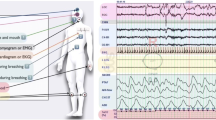Abstract
The reference method for measuring respiratory effort and for differentiating between obstructive and central apneas in the diagnosis of sleep-related breathing disorders is overnight monitoring of esophageal pressure. Despite this being the reference method, it is not widely used because it is considered invasive and uncomfortable for the patients. The aim of this study was to assess patient discomfort and insertion difficulty when using an esophageal catheter during polysomnography. We have performed a prospective questionnaire-based clinical study in 799 consecutive patients where polysomnography with an esophageal catheter was routinely performed in the diagnosis of sleep-related breathing disorders. The main outcome measures were the catheter-related discomfort experienced by the patient and difficulty of catheter insertion reported by the sleep technician. Ninety-six percent of the patients accepted the insertion of the catheter, and most of the patients considered it acceptable to sleep with the catheter. Correspondingly, in most of the patients, the catheter was easily inserted, and there were difficulties in only a few patients. Specifically, no complications or side effects were reported when using the catheter. To optimize the diagnosis of sleep-related breathing disorders, an esophageal sensor catheter can be used during polysomnography, without causing major patient discomfort.

Similar content being viewed by others
References
Anonymous (1999) Sleep-related breathing disorders in adults: recommendations for syndrome definition and measurement techniques in clinical research. The Report of an American Academy of Sleep Medicine Task Force. Sleep 22:667–689
Akre H, Borgersen AK, Mair IW, Skatvedt O (2000) Tracing air flow and diagnosing hypopnoeas in normal subjects. Physiol Meas 21:221–227
Akre H, Skatvedt O, Oeverland B, Borgersen AK (1999) Internal thermistors in differentiating between oral and nasal breathing during sleep. Acta Otolaryngol 119:934–938
Boudewyns A, Willemen M, Wagemans M, De Cock W, Van de HP, De Backer W (1997) Assessment of respiratory effort by means of strain gauges and esophageal pressure swings: a comparative study. Sleep 20:168–170
Chartrand DA, Jodoin C, Couture J (1991) Measurement of pleural pressure with oesophageal catheter-tip micromanometer in anaesthetized humans. Can J Anaesth 38:518–521
Chediak AD, Demirozu MC, Nay KN (1990) Alpha EEG sleep produced by balloon catheterization of the esophagus. Sleep 13:369–370
Chervin RD, Aldrich MS (1997) Effects of esophageal pressure monitoring on sleep architecture. Am J Respir Crit Care Med 156:881–885
Gould GA, Whyte KF, Rhind GB, Airlie MA, Catterall JR, Shapiro CM, Douglas NJ (1988) The sleep hypopnea syndrome. Am Rev Respir Dis 137:895–898
Guilleminault C, Stoohs R, Clerk A, Simmons J, Labanowski M (1992) From obstructive sleep apnea syndrome to upper airway resistance syndrome: consistency of daytime sleepiness. Sleep 15:S13–S16
Guilleminault C, Stoohs R, Kim YD, Chervin R, Black J, Clerk A (1995) Upper airway sleep-disordered breathing in women. Ann Intern Med 122:493–501
Haraldsson PO, Carenfelt C, Tingvall C (1992) Sleep apnea syndrome symptoms and automobile driving in a general population. J Clin Epidemiol 45:821–825
He J, Kryger MH, Zorick FJ, Conway W, Roth T (1988) Mortality and apnea index in obstructive sleep apnea. Experience in 385 male patients. Chest 94:9–14
Hessel NS, Laman M, Ammers van VCPJ, Dujim van H, Vries de N (2003) Feasibility study of flextube reflectometry for localisation of upper airway obstruction in obstructive sleep apnea. Rhinology 41:87–90
Hoffstein V (1996) Snoring. Chest 109:201–222
Hultcrantz E, Johansson K, Bengtson H (1999) The effect of uvulopalatopharyngoplasty without tonsillectomy using local anaesthesia: a prospective long-term follow-up. J Laryngol Otol 113:542–547
Lavie P, Herer P, Hoffstein V (2000) Obstructive sleep apnoea syndrome as a risk factor for hypertension: population study. BMJ 320:479–482
Littner MR, Shepard JW (1999) Recommendations for research into measurement and classification of sleep disordered breathing: gazing into the crystal ball. Sleep 22:665–666
Loube DI, Andrada TF (1999) Comparison of respiratory polysomnographic parameters in matched cohorts of upper airway resistance and obstructive sleep apnea syndrome patients. Chest 115:1519–1524
Maisel RH, Antonelli PJ, Iber C, Mahowald M, Wilson KS, Fiedler B, Schluter J (1992) Uvulopalatopharyngoplasty for obstructive sleep apnea: a community’s experience. Laryngoscope 102:604–607
Moser NJ, Phillips BA, Berry DT, Harbison L (1994) What is hypopnea, anyway? Chest 105:426–428
Pancer J, Al Faifi S, Al Faifi M, Hoffstein V (1999) Evaluation of variable mandibular advancement appliance for treatment of snoring and sleep apnea. Chest 116:1511–1518
Partinen M, Palomaki H (1985) Snoring and cerebral infarction. Lancet 2:1325–1326
Phillips BG, Somers VK (2002) Sleep disordered breathing and risk factors for cardiovascular disease. Curr Opin Pulm Med 8:516–520
Reda M, Gibson GJ, Wilson JA (2001) Pharyngoesophageal pressure monitoring in sleep apnea syndrome. Otolaryngol Head Neck Surg 125:324–331
Redline S, Sanders M (1997) Hypopnea, a floating metric: implications for prevalence, morbidity estimates, and case finding. Sleep 20:1209–1217
Skatvedt O, Akre H, Godtlibsen OB (1996) Continuous pressure measurements in the evaluation of patients for laser-assisted uvulopalatoplasty. Eur Arch Otorhinolaryngol 253:390–394
Skatvedt O, Akre H, Godtlibsen OB (1996) Nocturnal polysomnography with and without continuous pharyngeal and esophageal pressure measurements. Sleep 19:485–490
Stradling JR (1993) The sleep study, recording and analysis. In: Handbook of sleep-related breathing disorders. Oxford University Press Inc, New York, pp 87–113
Tvinnereim M, Miljeteig H (1992) Pressure recordings—a method for detecting site of upper airway obstruction in obstructive sleep apnea syndrome. Acta Otolaryngol [Suppl] 492:132–140
Waller PC, Bhopal RS (1989) Is snoring a cause of vascular disease? An epidemiological review. Lancet 1:143–146
Acknowledgements
The authors wish to thank I.W.S. Mair for assistance with the final version of the manuscript.
Author information
Authors and Affiliations
Corresponding author
Rights and permissions
About this article
Cite this article
Oeverland, B., Akre, H., Kvaerner, K.J. et al. Patient discomfort in polysomnography with esophageal pressure measurements. Eur Arch Otorhinolaryngol 262, 241–245 (2005). https://doi.org/10.1007/s00405-004-0792-2
Received:
Accepted:
Published:
Issue Date:
DOI: https://doi.org/10.1007/s00405-004-0792-2




